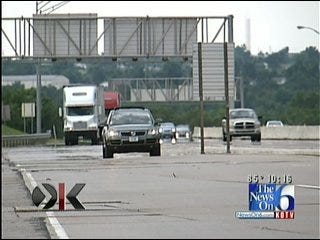Oklahoma Doesn't Make Profit On Turnpikes; Who Does?
What started out as one toll road connecting Oklahoma City and Tulsa has turned into a multi-billion dollar web of turnpikes across the state. Today, Oklahoma has 10 turnpikes, more than 600 miles of pavement, making the state second in the nation for miles of toll roads. <br /><br /><a href="http://www.news9.com/Global/category.asp?c=192033" target="_blank">OIT: Oklahoma Turnpike Interactive Map</a>Monday, July 19th 2010, 10:00 pm
By Jennifer Loren, The Oklahoma Impact Team
OKLAHOMA CITY-- What started out as one toll road connecting Oklahoma City and Tulsa has turned into a multi-billion dollar web of turnpikes across the state. Sixty-three years later, Oklahoma drivers are still paying that bill. Some lawmakers and citizens fear the Turnpike Authority has too much power.
Oklahoma has 10 turnpikes, more than 600 miles of pavement, making the state second in the nation for miles of toll roads.
"The turnpike is a scam on the people of Oklahoma," said Gary Richardson, 2002 Gubernatorial Candidate.
Richardson is an outspoken opponent of turnpikes. He ran for governor in 2002. His platform included putting the turnpikes under ODOT and getting rid of tolls.
"I believed it's a scam then and I know it's a scam today," said Richardson.
Richardson believes Oklahoma taxpayers should know more about the Oklahoma Turnpike Authority, how it pays for the roads and where their toll money goes. He blames the turnpike authority itself and state lawmakers for glossing over the truth.
"The state of Oklahoma does not make one red cent off the turnpike," said Richardson.
The State of Oklahoma does not make any money off the turnpikes.
Like many states, which lack adequate transportation funding, the toll roads are built with bonds and the bondholders are profiting off these toll roads... not the state.
So who are the bondholders? They are people, institutions and organizations all over the world who invest money in bonds and earn interest on that investment. In return, the Oklahoma Turnpike Authority must meet certain financial requirements. Those requirements are lined out in a covenant. The covenant requires the authority to keep a certain amount of money in its accounts at all times or else the bondholders can take over toll collecting operations.
"That is just not a responsible way to do state business," said State Senator Randy Brogdon.
As chairman of the Senate Transportation Appropriations Subcommittee, Senator Brogdon said that set-up is dangerous. In other states, bondholders are authorized to sue the turnpike organizations if they default, but not take over operations. Brogdon said Oklahoma gives bondholders and the Oklahoma Turnpike Authority too much power over state transportation issues. He said it wasn't set up that way in the beginning.
With little money available for transportation projects, state lawmakers created the Oklahoma Turnpike Authority in 1947. They also provided for construction of the state's first turnpike, the Turner, between Tulsa and Oklahoma City. It was financed with $38 million in bonds. Toll collections would pay off that debt and the Turner would become a free highway. But that soon changed.
State lawmakers liked the idea of pay-as-you-go roads so much they told the turnpike authority they could sell more bonds, build more turnpikes and keep collecting tolls until all turnpikes are paid off.
"We propose to make it possible for the drivers of Oklahoma to have these better roads and to pay as we go," said Governor Henry Bellmon in a 1965 news conference. "These bonds we're talking about are all self liquidating bonds. They don't cost the general fund a penny. And it is far different than the national administration of running our nation into debt further and further every year because they don't have the political courage to pay as they go."
Today, the Turnpike Authority's debt sits at $1.1 billion and it won't be paid off until 2028. The authority pays about 5 percent interest on that debt. So the bondholders will profit close to 60-million dollars from Oklahoma turnpikes this year alone.
"You know they'll never probably pay the debt off," said Senator Brogdon. "They don't have any intentions of paying the debt off. When they get close, they'll pass another bond issue, uh, extend that indebtedness so they can keep that money coming in."
One reason the turnpike authority would take out more bonds would be for more projects.
It turns out, the state has pre-approved the Turnpike Authority to build up to 25 more turnpikes.
"We don't have any plan to construct new turnpikes at the moment," said Tim Stewart, Deputy Director of the Oklahoma Turnpike Authority.
Stewart said the turnpikes they're pre-approved to build would not make enough money to make sense, at least not right now.
"The conditions could change in the future that may change that. But we don't see that right now," said Stewart.
Right now the state's in a recession. That's even more reason, according to critics, people should be concerned about the autonomy of the turnpike authority. After all, it did raise tolls 16 percent in the middle of the downturn.
Senator Brogdon was so angry about the timing of that hike he authored a bill requiring the Oklahoma Turnpike Authority to get legislative approval before raising tolls.
"If we really need to raise the rates then let the legislature do that, not have unelected bureaucrats making that decision," said Brogdon.
The bill was defeated, but 16 other senators voted for it.
Critics say, ultimately, the only way to fix the system will be through major reform. They say the governor is the only person with the power to reform the turnpike authority. He appoints the director and the board who make all the important decisions.
View our interactive timeline: "Turnpike Timeline: An Historical Road Map"
Thank you to the Beryl Ford Collection/Rotary Club of Tulsa, Tulsa City County Library and Tulsa Historical Society for providing photos for this story.
More Like This
July 19th, 2010
January 2nd, 2025
September 29th, 2024
Top Headlines
May 13th, 2025
May 13th, 2025












